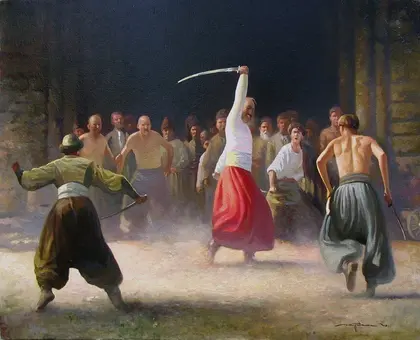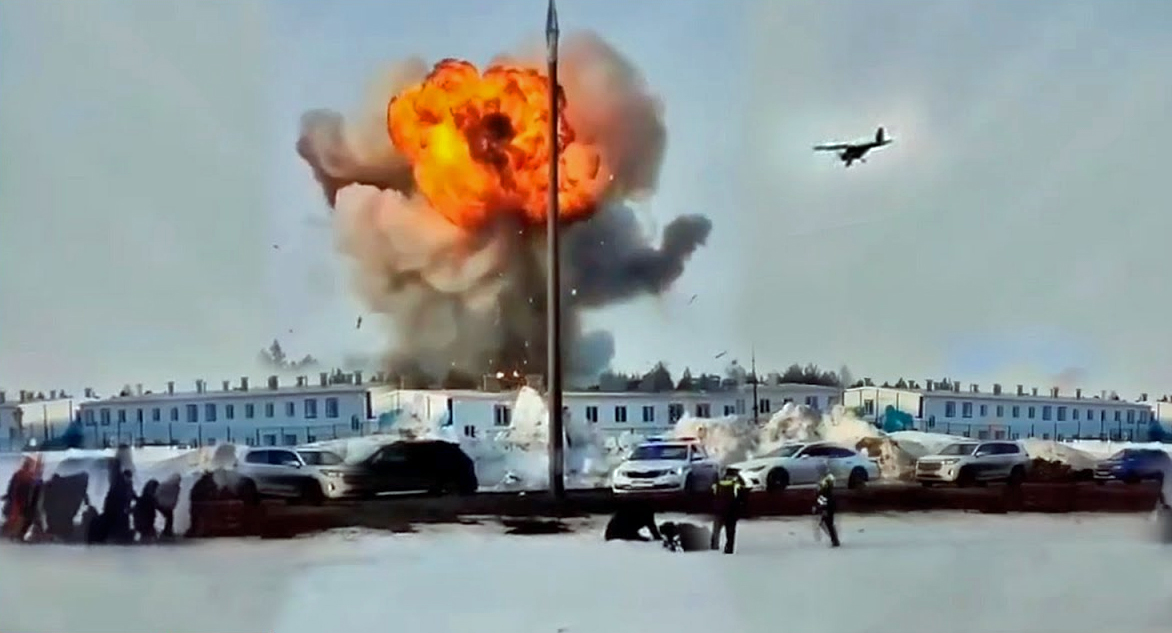If for a time Russian bravado prevailed and recaptured the headlines, the war, presently in its fourth month, has seen the sheen dramatically fade from Russia’s blustering pronouncements of its phase-two war aims, severely eroded by the sinking of the Russian Black Sea flagship Moskva, continuing reports of Russian generals getting killed, Russian command posts being turned into rubble as well as the very uneven or tepid progress in Donbas, even in cratered Mariupol.
In its stead, interestingly enough, a tweaked version of the Ukrainian resilience theme has quietly reappeared as a serious nightly-news talking point, with the critical issue being whether the Ukrainians possess the reserve fortitude to do a repeat of their Kyiv victory in Donbas. Equally interesting, Western media has focused once more on a historical perspective in attempting to measure the capacity of Ukrainians for sustained tenacity.
JOIN US ON TELEGRAM
Follow our coverage of the war on the @Kyivpost_official.
In a particularly poignant case in point, a recent interview featured a Donbas farmer working in an armored tractor with his combat class helmet on, trying to get his seeds planted despite all the devastation around him. He is shown beaming with pride at doing his duty to the homeland and professing that his Cossack ancestors would have expected no less.
Indeed, the Ukrainian resilience theme deserves to be heartily lauded and energetically pursued. In fact, it should be recognized as offering real hope for finally reaching beyond flavor-of-the-week discussion cues and getting a handle on the general direction of a conflict that is already defining the early 21st century and may end up determining much more.

ISW Russian Offensive Campaign Assessment, December 24, 2024
For one, few observers of the struggle (including the Russians themselves) would now deny that a reprise by the Ukrainians of their victory in Kyiv, which constitutes a confirmation of their capacity for sustained resilience, could effectively change the parameters or nature of the war. Even DNR, LNR and Crimea, still considered by most of the world as Ukrainian territory, could be in play from a military point of view. And the blowback into Russia could equal that generated in the aftermath of the Russo-Japanese War of 1905, where a perceived weaker power also bested a perceived stronger power.
Freedom loving Cossacks
Two, Ukrainian history is precisely the place where one would explore the reprise matter. It possesses a very rich record with regard to the issue of a national predilection for persistent perseverance in the face of frightening odds – actually, much too rich. For purposes of example, four key episodes in the story of Ukraine would probably suffice.
The first episode involves the descendants of medieval Kyiv who found shelter in Zaporizhzhia and whom the contemporary Ukrainian farmer deemed worth mentioning as his spiritual mentors – The Cossacks. The Zaporizhzhian Host, as the Cossacks came to be known collectively, developed in the 15th and 16th century into a free-wheeling, land owning elite military caste on the frontier of Europe. They eventually helped create the second iteration of the Ukrainian state (medieval Kyiv Rus being the first) known as the Hetmanate (1647) and then withdrew back to their home region to let the Hetmanate find its own firm ground without their interference.
Lo and behold, in 1683, the Ottoman Empire decided to make a major move on Europe. In an attempt to conquer its very heartland, Turkish forces arrived at the gates of Vienna, seat of the Holy Roman Empire, the responsibility of the Habsburgs at the time. The Habsburgs wisely put the defense of the city in the able hands of the head of another powerful European state, Polish- Lithuanian Commonwealth ruler Jan Sobieski. He, in turn, turned to the Zaporizhhians for help, having engaged them earlier in friendly and less than friendly circumstances.
The Zaporizhzhians arrived in Vienna too late to make an impact on lifting the Turkish siege that Sobieski and the Polish cavalry brilliantly managed, but they were given the task of rooting out the Ottoman forces in Hungary, which they did to tremendous effect. After the double defeat, the Ottomans never ventured back to Europe in a serious way. As a wonderfully anecdotally token of appreciation, one of the Zaporizhzhians (actually, a Western Ukrainian accomplice), Mykhailo Kulchytsky, was awarded the entire supply of coffee the Turks left behind and ended up opening Vienna’s first coffeehouse.
Ukrainian freedom fighters in the 20th Century
The second episode would see the Ukrainians and Poles once again working in tandem against an existential threat from the East – this time, Russian imperialism in its various stripes. In early 1919, Simon Petliura, head of the third iteration of the Ukrainian state, the Ukrainian National Republic, having lost control of Kyiv as a result of attacks by Russian armies of both the White Guard and Red Guard, turned to a fellow European Social Democrat, Polish leader Josef Pilsudski, to beat back the forces of Russian imperialism, whatever the color, and regain control of the Ukrainian capital.
The two went to work quickly and did precisely what Petliura had intended, taking back Kyiv in mid May. However, the Reds (Bolsheviks), having defeated the (Czarist) Whites and received reinforcements from Siberia, began a new offensive in the summer, first driving Petliura and Pilsudski out of Kyiv and then heading for Warsaw.
Petliura and his army had the possibility of remaining in Ukraine and turning into an insurgent force, but instead they decided to stay with Pilsudski and prepare for the defense of Warsaw. The Ukrainians under the generalship of Marko Bezruchko took the southern (or right) front and deftly kept the Bolshevik army from turning the said Polish flank at a critical point in the Battle of Warsaw, also known as the Miracle on the Vistula. The ensuing victory kept Poland and, for that matter, a large number of newly minted central and eastern European nation states, from Bolshevik domination for another two decades, allowing them to more strongly develop their national identities.
The Ukrainians, unfortunately, did not benefit from the Miracle, having being splintered by 1920 into four parts. Worse still, the largest splinter was taken by the Bolsheviks, with all the consequences that fact entailed, including the genocidal Holomodor.
The third episode would continue with a Bolshevik component but add another genocidal regime, Nazi Germany, into the mix – with the Ukrainians stuck in the middle. For all of Russia’s present day talk of chasing Nazis away from Ukraine, it was one of Putin’s predecessors in the Kremlin, Josef Stalin, who made a “Pact of Steel” deal in 1939 with his maniacal Nazi counterpart, Adolph Hitler, to pick up real
estate that Moscow had not managed to pick up in 1920, after the Miracle. Within two years, Hitler, having used Stalin’s steel and wheat (taken from Ukraine) to conquer European lands north, west and south, decided to betray his naive buddy and head east. The “Great Patriotic War” ensued.
The Ukrainians from the three western splinters, unencumbered by the trappings of a Bolshevik mindset, took to opposing both totalitarian systems equally, despite the Cold War Soviet dezinform ops that claimed otherwise. An armed underground resistance movement that morphed into a more formally structured Ukrainian Insurgent Army (UPA) emerged to do battle, first with the Nazis in 1943-1944 and then the Bolsheviks from 1944 until 1952. The valiant struggle received no outside aid, no Lend Lease.
When captured and sent to either Nazi KZs or Gulag camps, the Ukrainians were reputed to be among the toughest nuts to crack. The Ukrainians from the eastern splinter, trapped in a Bolshevik framework of reality, chose to do battle with only the brown (i.e. Nazi) version of totalitarianism. But here too, the Ukrainians shined. After June 1944, Ukrainians made up 40% of the Soviet forces plowing through East Europe, and it was the First Ukrainian Front armies that took Berlin from Hitler in 1945.
The final episode would begin in the aftermath of the mentioned Ukrainian struggles of the 40s and early 50s. While Nazism was extinguished, Bolshevism lingered, expanding its grip for four decades on to all of eastern Europe. In the process; it took all of Ukraine’s splintered pieces and glued them together. By doing so, the red brand of Russian imperium made a terrible mistake. Western Ukrainians, finally able to live together and embrace their eastern brothers and sisters, slowly but with great purpose, brought home (using the dissident movement in the 60s & 70s) the idea of ending the last prison of nations.
21st Century Revolution
Once an opportunity presented itself with the Kremlin’s crisis of faith (in Bolshevism) in 1989-1991, the Ukrainians bolted for the door. In a referendum in December 1991, they voted 91% in favor of leaving the USSR and living in an independent Ukrainian polity. In the 2004 Orange Revolution and the 2014 Revolution of Dignity, an additional message was sent to the northern neighbor, which was increasingly sporting a (KGB) blue version of Russian imperium: the fourth iteration of the Ukrainian state intended to get as far away from the Russian World, of whatever stripe, as it possibly could.
The reigning ruler in the Kremlin, a self-styled restorer of the glory of the USSR, got the message and struck back with an invasion of Crimea and a hybrid war in Donbas. The move caught Ukrainians short handed in as much as the pro-Putin Yanukovych regime ousted in 2014 had reduced the actual number of regular troops available for defense of the homeland to less than 10,000. Undeterred, the new Ukrainian government turned to the veterans of the Revolution of Dignity and organized them into volunteer battalions. These battalions, eventually organized as a National Guard, stepped into the breach and stopped Putin cold in his tracks. Donbas devolved into a trench war, a terribly frustrating result for Vlad the Restorer. More frustrating still, contemporary Ukrainian heroes were born out of the Donbas fight. The story of the vastly outnumbered and outgunned Cyborgs defending Donetsk airport for several months filled many Ukrainian 13-year-olds with pride and a desire to emulate.
Armed with insights culled from the just elaborated episodes of Ukrainian history, it would not be difficult to envision a credible construct for forecasting the end result of the war – a final narrative, if you will. It is clear from the evidence that Ukrainians are capable of fighting above – and often well above – their weight class. It is also abundantly clear that they have always possessed that capacity.
Staying with the boxing analogy, the Ukrainians can be said to be a lot like their great featherweight champion Lomachenko, who, because of his speed, dexterity and fight-smarts, has been able to conquer the junior lightweight and lightweight classes. Now add two more items to the stated thought process. First, note the latest news indicating that the US is presently (after some initial hesitation) pouring a large number of weapons into Ukraine.
And then switch back to more boxing imagery. Just think of Lomachenko acquiring the arms and fists of a Ukrainian heavyweight champion, Vitaly or Volodymyr Klitchko. At that moment, a likely outcome of Russia’s gambit in Donbas should begin to emerge distinctively into view. Oh and yes – so should the fate of DNR, LNR and Crimea. Oh and yes again, so should the analogous relationship between the Russo-Japanese War and Russo-Ukrainian War.
So let give credit to Ukraine where credit is due, and all else will follow: that is, if Vlad the Bad does not try to become Vlad the Mad.
About the Author: Walter Zaryckyj is executive director of the Center for US-
Ukrainian Relations. Zaryckyj completed his undergraduate and graduate work at
Columbia University and taught political science at New York University for nearly three decades. He is now engaged in postdoctoral research on Eastern Europe.
You can also highlight the text and press Ctrl + Enter






